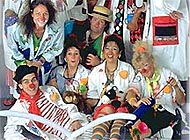Clown doctors have child patients in stitches

There is one kind of doctor whose bedside manner will nearly always leave you in stitches and tickle your funny bone. Dressed in a white coat, the clown doctor is always in the house when there is an emergency to deliver some special laughter treatment.
The Theodora Foundation was set up in Switzerland seven years ago to ensure children all over the world get a regular dose of laughter to speed their way to recovery. Now there are some 50 clown doctors of 15 different nationalities working all around the globe, from South Africa to Belarus to Hong Kong.
André Poulie, who created the foundation and named it in memory of his mother, says the clown doctor knows no borders. “The wonderful thing,” he smiles, “is to see there is absolutely no difference between a child who is in Soweto, and a child who is in Zurich. They smile, and have the same reactions in front of the same silly figure of a clown doctor.”
Poulie knows from personal experience what it is like to be a child patient. When he was just ten years old, he had a bad accident with a lawnmower. He spent the next two years going through 14 operations, and says he lived from the inside, what it is to be a child in a hospital.
“It was in 1974, and in those years the hospital was an old-style hospital where you had a big room, my parents could only be with me for a couple of hours a day. Even for my birthday, we had to negotiate so that my brother could come for two minutes. This has of course had an impact on me.”
But it was not until tragedy struck again in the family, with Poulie’s mother, Theodora, being diagnosed with cancer, that the idea was first conceived. Poulie says even throughout her illness his mother managed to retain her humour and that it brought home to him, how laughter could give a patient the energy to see them through great difficulty and stress. A year later, the Theodora Foundation burst into being.
Clown doctors are not, strictly speaking, trained medics. However, it could be argued the criteria for attaining a qualification to clown around in a white coat is just as tough. Not only do you have to be emotionally stable, in order to cope with the often harrowing experience of being on a children’s ward, you have to be highly sensitive, creative and of course, funny.
Poulie says during the selection process, each candidate is told at the end of the interview that they have five minutes to improvise a short sketch using the props provided. “This is what happens in hospital,” Poulie explains. “They enter a hospital room, they will not know what they will find behind this door and the situation of the child, so this is how we really test the artistic capacity.”
Out of around 60 would-be clown doctors, only around ten make the grade.
Clown Miitou, otherwise known as Heidi Rodriguez, is from the German-speaking eastern part of Switzerland, but now works as a clown doctor in and around Lausanne. More than six years ago, she became the first female clown doctor, after getting through the rigorous selection process, including the improvisation test, as well as around six months of training. All clown doctors learn about how a hospital functions, about different treatments and their impact on child patients, hygiene and psychology.
Apart from her duties as a clown doctor, Miitou is a professional children’s entertainer, like most of her colleagues at the Theodora Foundation. She says making kids laugh is not always the absolute priority…what makes it worthwhile is establishing a connection with a patient.
“If he is in pain, I can’t expect him to laugh at me,” she says. “If he’s in shock or something, or under medication, he doesn’t have his normal capacities. Those kinds of circumstances you have to take into consideration and not expect everything of the patient.”
Once in a while, though, the child patient’s reactions exceed expectations. Doctor Kiku is a clown doctor who works in London’s Great Ormond Street and Guy’s and Saint Thomas’ hospitals.
Recounting one particular experience from four years ago still brings tears to his eyes: “I went to see a young girl…she was in a coma… and I sat with her, I read her a story, I grabbed her hand and said ‘This is Doctor Kiku’….and I played a couple of songs on two different instruments and the last thing I said was, ‘I’m going to blow some bubbles on your legs, and I’ll be very cross if you don’t tell me you can feel them. I did that, and she came out of her coma.”
Each clown doctor has a different specialisation. For Doctor Kiku, it is magic tricks peppered with a comedy routine, for others, it is mime, or percussion. André Poulie says the clown doctors are assigned a particular hospital where they appear regularly, week in and week out to give child patients a sense of continuity. He says this complements the work of the trained medical staff of the hospital, who have come to understand the powerful healing properties of a laugh and a smile.
by Jamsheda Ahmad
www.theodora.org

In compliance with the JTI standards
More: SWI swissinfo.ch certified by the Journalism Trust Initiative
You can find an overview of ongoing debates with our journalists here . Please join us!
If you want to start a conversation about a topic raised in this article or want to report factual errors, email us at english@swissinfo.ch.